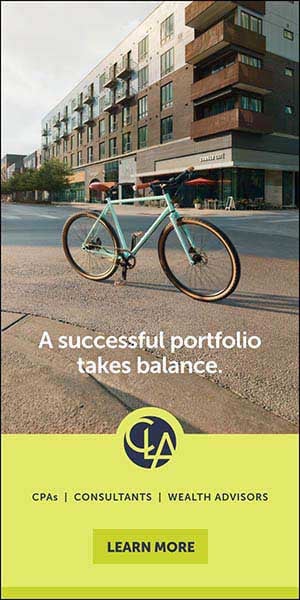The Challenges Of Bringing a Museum to Market

Museum development requires collaboration among designers, contractors and museum operators.
NO ONE REALLY knows how many museums open — or close — in America each year. No single registry or governing body keeps track of them. But museums are big business. According to the Institute of Museum and Library Services (IMLS), the U.S. was home to about 35,000 active museums, libraries and private collections in 2014. And, according to the American Alliance of Museums (AAM), 850 million people visited U.S. museums last year, contributing $21 billion to the U.S. economy.
Few are the size and scope of the Museum of Modern Art or any of the Smithsonian Institution museums. IMLS data shows that most are small, with less than $10,000 of annual income. There are museums for everything imaginable, from the Hammer Museum in Haines, Alaska, which celebrates the construction implement, to the Wyoming Frontier Prison, Wyoming’s first state penitentiary, in Rawlins.
Americans, particularly those who conceptualize, design and build museums, have turned these institutions into an art form all their own.
A Long and Winding Road
Developing museums is often a long, collaborative process, with many agendas and politics to maneuver around. Many take decades to come to fruition.
The 118,000-square-foot Museum of the American Revolution (MoAR) in Philadelphia was more than 100 years in the making. The Valley Forge Historical Society had been collecting Revolutionary War artifacts since the early 1900s. It was initially anticipated to be in Valley Forge, but a land swap with the U.S. National Park Service in the early 2000s allowed the $120 million privately funded museum to be located at Independence National Historical Park in Center City Philadelphia.
Robert A.M. Stern Architects (RAMSA) has been involved with the building since 2002. Alexander Lamis, FAIA, who headed the project for RAMSA, reflects that “George Washington mustered his troops down Chestnut Street, right past the museum site. Franklin Court is a block away. We have one foot in the park and one in the city. It’s a vibrant neighborhood and the location could not be better.”
With an exterior Lamis describes as “restrained Classicism,” the MoAR features three floors. From the moment one enters the rotunda through the domed bronze-cladded entrance, there’s a sense that the building’s been in place for decades — an amazing feat as it only opened in April 2017.
The cross-vaulted ceiling in the lobby features an illuminated laylight — a glazed panel set flush with the ceiling — representing the six-pointed star from Washington’s standard flag, which is in the museum’s collection. The galleries are organized around a sky-lit central interior court with terrazzo floors and a grand elliptical staircase.
Lamis explains that the cornice lines of the building are designed to align with those of neighboring buildings, so that it feels “as if it has been there forever.” Someone glancing at the building might not even realize that the second floor, which houses most of the galleries and Washington’s campaign tent, the museum’s crown jewel, has no windows.
“Museums are a challenge in cities,” he adds. “You have to control the light to protect the artifacts, and yet you want it to feel welcoming and expansive.”
The museum includes permanent and temporary exhibit spaces, a public plaza, a 190-seat theater, retail space, a cafe and event space with terraces off the third floor. The lower level includes classrooms and storage space. It is also the temporary home for the tens of thousands of artifacts found during the excavation of the site.
Speed to Market
Some museums do get off the ground quickly. The privately funded, $505 million Museum of the Bible (MOB), which is scheduled to open in November 2017, has gone from concept to execution in just six years. Museum director Cary L. Summers attributes that to two things.
“Most of our team members came from the theme [park] industry, where speed and flexibility are the norm,” he says. “And we had some great advice from Francis Rooney of Manhattan Construction (and a member of the U.S. House of Representatives), who told us, ‘get everyone in one room on Day One so that everyone hears the same thing.’ We’ve made that a priority.”
Brian Flegel, senior vice president of general contractor Clark Construction, says that even with everyone on the same page conceptually, with six different exhibit designers, communication could be challenging. Each design firm has a different platform or storytelling methodology, which meant that each part of the building required a different approach. Whereas one floor may have ancient artifacts and scrolls, another may be based entirely in techno-media storytelling.
But, the philosophy of getting everyone in the same room — or conference call or email chain —paid off. “Through a closely woven partnership of client, designers, contractor and subcontractors, we will deliver this museum in half the time of any museum in its class. This highly collaborative environment has allowed creativity and ingenuity to thrive, despite the accelerated pace, without sacrifice to quality in building a world-class guest experience,” adds Flegel.
The eight-story building is a complex structure that included the renovation of the historic Terminal Refrigerating and Warehousing Co. building (which formerly housed the Washington Design Center), the addition of a floor to an existing office building next door and the creation of a modern atrium (along with a long span structure to accommodate multiple theaters) to serve as a connecting “hyphen” between them. Two floors were added to the historic building to house a 470-seat performing arts center and a 500-seat “gathering room” for events.
“From the beginning, we all believed the Museum of the Bible had to stand up to the architecture of the Smithsonian and the National Gallery of Art,” says David B. Greenbaum, FAIA, LEED AP, vice president of SmithGroupJJR, the project’s architect. “This is a building that has to be taken seriously in terms of architecture, yet be relatable to almost anyone who would visit.”
Fitting In
To Greenbaum’s point, another challenge facing today’s museums involves their relationship with the surrounding neighborhood. At Scottsdale’s Museum of the West, which opened in 2015, architect Christiana Moss of Studio Ma relates that the museum’s design is intended to celebrate the “epic beauty and bigness” of the Arizona desert, to “showcase the context and be of it.”
That approach echoes through nearly every aspect of the LEED Gold-certified facility. The museum’s warm earth tones and light-filled lobby beckon visitors. A central courtyard serves as a connector to light and nature, making the building feel as if it is part of the landscape. A rain screen of rusted metal panels evokes the fencing used by early settlers, while a bison “grazes” on dry, cracked “earth” in the lobby. A theater/auditorium with an undulating ceiling is the centerpiece and anchor of the museum.
A sculpture garden features contemporary architectural design and desert plantings. Moss and her partner, Christopher Alt, designed a “weeping wall” that collects rainwater from the roof and HVAC condensation. The water travels across the museum campus through an irrigation system to provide water to the landscaping. It also serves another, equally important use: telling the story of water in the desert.
The $11.5 million project was a public-private partnership with a very tight budget. The city funded the building while a nonprofit organization covered the interior costs. To save time and money, the museum was built like a warehouse, with tilt-up concrete panels and steel joists. The architects used a variety of tactics to weather the exterior, and incorporated into the interior natural elements such as scented cedar planks and textured materials to awaken the senses.
The museum’s director, Mike Fox, says “It’s the Old West meeting the New West. We are a hybrid, not singularly an art museum, or a cultural center or a history museum, but a combination of all three. The choice of materials and their utilization in the design clearly annunciates that connection of old and new.”
Standing Out
Just as clearly, the Neon Museum in Las Vegas, which opened in 2012, stands out from its desert setting. Rob McCoy, the museum’s CEO, calls it “the sexiest museum in the world.” With more than 200 classic signs and a total of 600 pieces, there is nothing circumspect about the mostly outdoor museum.
Planning for the museum began in the late 1980s, when the city began to reinvent itself and started demolishing buildings. The Allied Arts Council worked to save many of these structures’ signs for a future museum. At the same time, YESCO (the Young Electric Sign Co.), which had built many of the signs, was constructing its own “boneyard,” which makes up about 30 percent of the Neon Museum’s collection today.
In the 1990s, the city of Las Vegas became interested in creating the museum to showcase the city’s neon history. It provided land for the project, which it leases to what is now the Neon Museum for $1 a year. But it took several more years, until the family that owned the soon-to-be-demolished La Concha Motel donated its historic lobby building to the project, for the museum project to fully come together. Designed by the famed architect Paul Revere Williams in the Googie style, the motel lobby was dismantled into several pieces, trucked across town and attached to a new building constructed for the museum. It now serves as the Neon Museum’s visitor center.
“This was a tremendous challenge, but it’s had a terrific impact on Las Vegas,” says McCoy. “We had more than 100,000 visitors last year and the trend line for this year is rising. Next, we will expand our outside gallery for another 35 signs and then build an indoor gallery for the dozens of pieces we have in storage, as well as a fabrication area so people can see how neon is made. Las Vegas has not done a very good job preserving our history, so we will do this right.”
Control Is Key
Bringing a museum to market is a rigorous affair. Timing, budgets and passion all must align. Designers, developers and contractors must work closely with museum staff as well as any other partners in the project, to ensure that it is completed on time and within budget — and that it meets the needs of museum staff and visitors.
Fox, director of Scottsdale’s Museum of the West, underscores the need to “know your budget and have the conviction that you can meet your project’s goals with it.” He adds, “throughout the process, have your contractor continuously bid on the various dimensions of the design, so you know at all times where the design lines up with the project and [are assured there will be] no surprises at the end.”
Control during the development process is also critical.
“Have one project manager,” recommends the Neon Museum’s McCoy. “[There can be] too many cooks, especially when you’re dealing with melding a new building and an old one; with designers, contractors, a preservation office and a board. The museum needs to call the shots. We own the final product. We have to live with it.”
Robbie Tarpley Raffish is a freelance writer based in Maryland.
Museum of the American Revolution Finds Artifacts Underfoot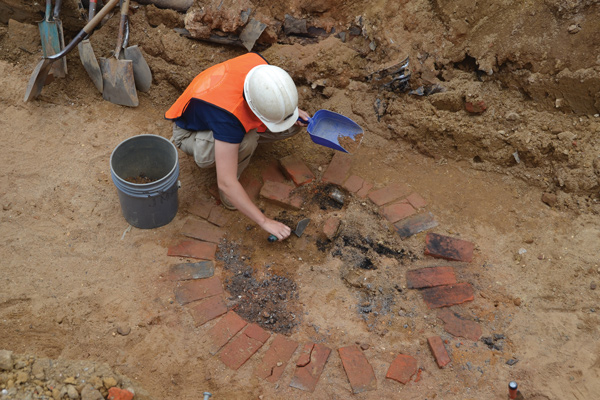 Archeologists sifting through the site of the Museum of the American Revolution uncovered hundreds of artifacts, one of which is now on display at the museum. Dig anywhere in Philadelphia and you’re likely to come across an artifact or two: arrowheads, pottery shards, metal tools. But when archeologists working on the site of the Museum of the American Revolution began sifting through the site at Third and Chestnut streets, they uncovered an amazing 85,000 artifact pieces that together created a record of occupation of the site from the earliest settlements through the mid-20th century. The initial dig took three months. Development paused twice more as additional artifacts were found. One of the most extraordinary finds was a rare punch bowl with an image of the sailing ship Tryphena, which sailed between Liverpool and Philadelphia and, in 1765, carried a petition from the merchants of Philadelphia asking their counterparts in Great Britain to reconsider the Stamp Act, one of the major grievances that started the rift between the colonists and the mother country. Another group of artifacts came from what appears to be a mid-18th century tavern on Chestnut Street and included many red earthenware vessels made by local potters. But the most significant find was almost missed. A shattered —and painstakingly reassembled — small, inconspicuous white bowl made of hard-paste porcelain, it is considered the “holy grail” of American ceramics. The unassuming vessel shows how at least one Philadelphia craftsman replicated a Chinese pottery process that dates to the seventh century. The Tryphena bowl is now on display at the museum; other artifacts uncovered at the site will be featured in the future. “It seems only fitting that such a complete story of the evolution of the city should be found on the site of a future museum,” says Michael C. Quinn, the museum’s president and CEO. “These artifacts provide a tangible tie to Philadelphia’s past and help us tell the stories of the people who lived here before, during and after the Revolutionary War.” Project SummaryLocation Philadelphia |
The Museum of the Bible: Not Moses’ Tablet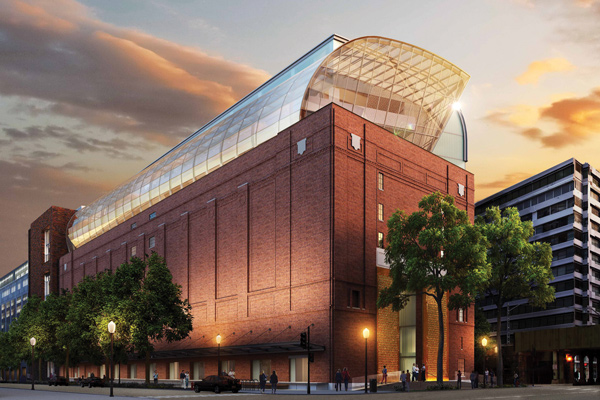 Two floors were added to the historic Terminal Refrigerating and Warehousing Co. building to house a 470-seat performing arts center and a 500-seat “gathering room” for events at the Museum of the Bible. It may seem counterintuitive, but one of the most highly anticipated elements of the new Museum of the Bible, opening in November 2017, is technical rather than historical. “The team involved in this project are longtime museumgoers, and we all knew, by default, what the customer wanted — and it wasn’t old, stodgy or boring,” says Cary L. Summers, president and CEO of the museum. “We are bringing the ‘ancient of ancients’ alive by using the latest technology.” It’s a $42 million investment that will include up to eight technology patents at opening. At the core of this technology is a dedicated interior GPS system. Each visitor will receive a data tablet at the museum entrance. The GPS system will be able to locate visitors within four inches of the nearest exhibits; “digital docents” will then share information about the exhibits as it pilots visitors along a path through the museum. 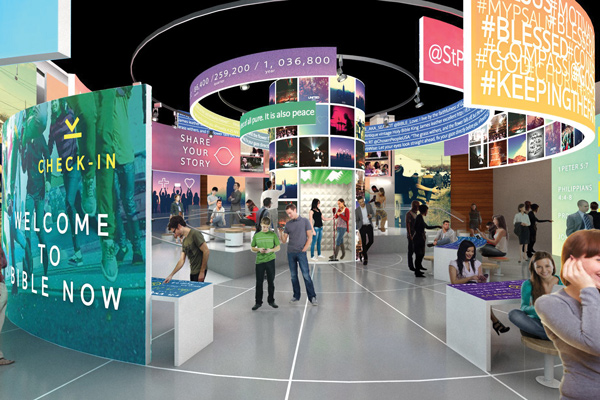 Museum visitors will receive tablets that will act as “digital docents,” sharing information as they guide them through exhibits. With six floors above ground and two below, not every visitor will have time to see every exhibit. The project’s fact sheet says it would take nine eight-hour days to read every placard, see every artifact and experience every activity in the museum. “Some people will only have a couple of hours to spend with us,” says Summers. The technology will enable museum guests to get the most out of their visits, however long or short. When their visits end, the system will provide guests with opportunities to extend their learning through online courses, speakers and, eventually, trips. The technology investment will not only pay off for the visitor; it may create another revenue stream for the museum. Summers and his team are committed to sharing the technology for a fee, as he says, to let “all boats rise,” to increase interaction at all types of museums. Project SummaryLocation Washington, D.C. |
Scottsdale’s Museum of the West: Built on a Challenging Foundation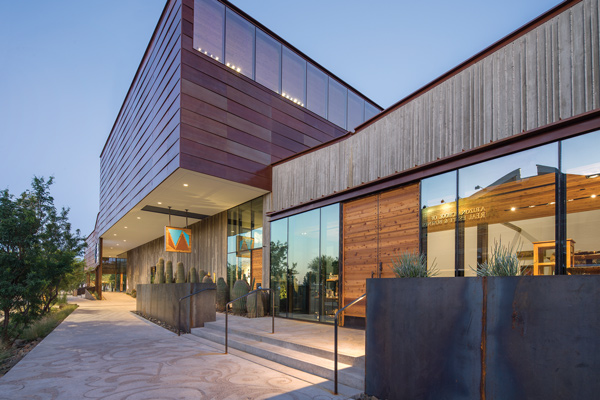 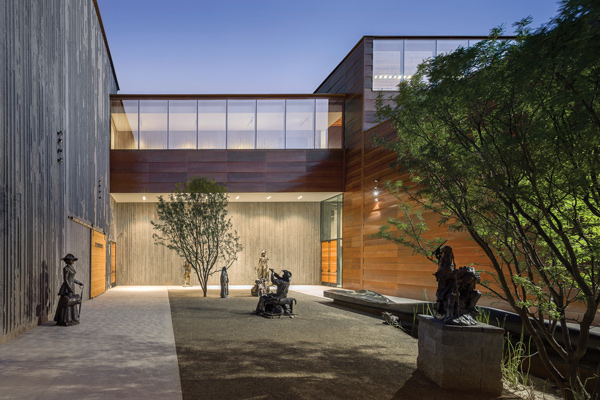 Scottsdale’s Museum of the West was designed to blend into its desert environment. Its sculpture garden features western sculpture, desert plantings and a bench carved from ponderosa pine. Photos by Bill Timmerman, courtesy Studio Ma Mike Fox, director of Scottsdale’s Museum of the West, often says that the institution “is not a museum of objects, but a museum of ideas.” That was never truer than when, in the midst of construction, the development team needed a really good idea, fast. Located on a brownfield that had initially been allocated by the city for a transit hub, half of the institution was being built on top of an existing parking structure. The other half was to be set on a new foundation located on an abandoned street. When it came time to lay the new foundation, the construction team uncovered fiber optic cable that served 2 million people in south Scottsdale. “Two foundation systems are challenging,” says Christopher Alt of Studio Ma, architect for the project. “But this was not even in the realm of what we expected to find.” The museum was on an extremely tight budget and needed an out-of-the-box resolution. CenturyLink (which owns the cable), the city of Scottsdale and the development team came together to brainstorm. The utility agreed to an unusual solution: it would allow the lines to remain under the building if secondary pathways, additional manholes and vaults were added outside the footprint of the museum so that cable could be serviced or rerouted, if needed. “This was western spirit at its best,” says Moss, another Studio Ma architect, “true bootstrapping to keep the budget under control and bring the project in on time. Project SummaryLocation Scottsdale, Arizona |
The Neon Museum Makes Signs Sing Again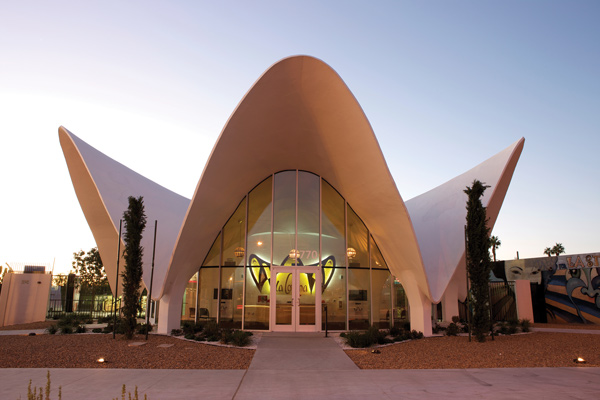 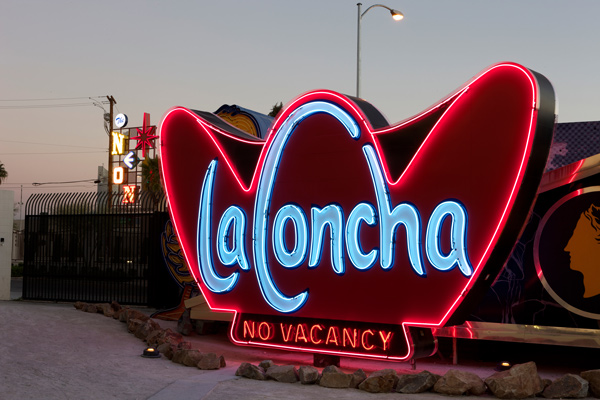 Originally constructed in 1961 on Las Vegas Boulevard South, the La Concha Motel lobby was a distinctive shell-shaped building, a striking example of Mid-century modern design characterized by atomic and space age shapes and motifs. It has been transformed into the Neon Museum’s visitor center, and a section of the hotel’s main roadside sign has been restored and illuminated as part of the museum’s rehabilitation efforts. The Neon Museum In the late 1980s, as Las Vegas began imploding its older hotels, sign designers around the city shuddered. Pieces of neon art that had defined Las Vegas for decades were abandoned, and some landmark signs, such as the one from the Sands Hotel, were demolished — lost to future generations. The Neon Museum, established in 1996 as a public-private partnership with the city of Las Vegas, is dedicated to preserving their history. But moving these electric works of art was not as easy as it sounds. Take the iconic “Stardust” sign. In its time, it was one of the largest neon signs in the world. Standing at 188 feet tall, it lit up the Las Vegas skyline. When the Boyd family, owners of the Stardust hotel, donated the sign to the museum, it had to be cut up into several pieces and transported by flatbed trucks across the city in the very early morning hours. The move cost $250,000, which was covered by special grant funding. During the last three decades, more than 200 signs and a total of more than 600 artifacts have been saved. In 2009, the stretch of Las Vegas Boulevard between Sahara and Washington avenues was designated a National Scenic Byway by the U.S. Department of Transportation, Federal Highway Administration, and the Neon Museum installed the Hacienda Horse and Rider sign at Fremont Street, followed by signs for Binion’s Horseshoe, the Bow & Arrow Motel, the Silver Slipper, Society Cleaners, Lucky Cuss Motel, and the Normandie Motel. 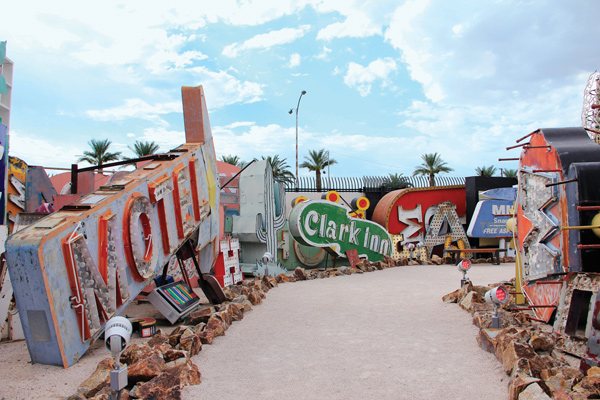 Visitors to the Neon Museum can take a guided tour through the Boneyard, which features more than 200 signs, seven of which have been restored to working condition. The Neon Museum “These signs will never again be created in the world,” said museum CEO Rob McCoy. “We have to do everything we can to preserve them for generations to come.” Project SummaryLocation Las Vegas, Nevada |


